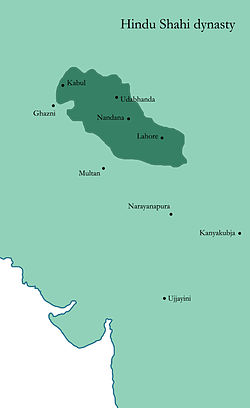Samantadeva
| Author:Laxman Burdak, IFS (R) |

Samantadeva (सामन्त देव) was a king of Hindu Shahi Dynasty at Ohind.
Variants
- Samanta (सामन्त)
- Samanta Deva (सामन्त देव)
History
Buddha Prakash[1] mentions ....[p.136]: After Lalliya, Samantadeva (सामन्त देव) ascended the Sahi throne at Ohind. His coins, they are elephant and lion type but mostly of the bull and horseman type, have been found at Sultanpur, Sunet, Joner and Kapalmochan in East Panjab, on the one hand, and near Rostow in the Yaroslavi province, Gniezdovo in the Smolensk province, Tatarski Tolkish in the Kazan province, now in the Tatar Autonomous Soviet Socialist Republic, Denissy in the Poltava province, Vaabina in the Estonian Soviet Socialist Republic, Obrzicho in Poland and Chivaz near Taskent, in the U.S.S.R. and eastern Europe, on the other. The discovery of his coins over such a wide stretch of territory from East Punjab to Poland shows that [p.137]: under him his kingdom had acquired considerable importance. Yaqubi states that, from the ninth century, Kabul was visited by tradesmen for the so-called mirobalan which was very much valued by the medical practitioners of medieval times. Trade in this as well as other commodities seems to have carried the coins of Samantadeva far abroad (A.A. Bykov, ‘Finds of Indian Medieval Coins in East Europe', Journal of the Numismatic Society of India, Vol. XXVII (1965) part II, pp. 146-156).
Thus it is clear that Samantadeva consolidated the Shahi Kingdom on the frontier so firmly as to make it a centre of economic progress and commercial prosperity. But soon internal troubles queered the pitch for him. A son of Lalliya, Toramana, advanced his claim to the throne and sought the help of Kashmira in support of it. Kashmira was keen to resuscitate her influence over the frontier state of the Shahis which was shaken when Lalliya overthrew Laghturman and befriended the Pratiharas of Kanauj who had acquired hegemony over the Panjab. Hence she took the occasion by the forelock and her minister, Prabhakaradeva, led an army against Ohind, overthrew Samantadeva and installed Toramana under the name Kamaluka or Kamalavarman (Rajatarangini, 232-233).
The new ruler issued the copper coins with peacock with outspread wings to left on the obverse and lion to right and the legend Sri Kamara on the obverse. It may also be that he issued the bull and horseman type of silver coins with the Iranian legend Shri Khudavayakaḥ , corresponding to Xvatāvaya, for circulation in the Iranian world. This revolution changed the balance of power on the frontier and brought the Shahis and Kashmira together against the Pratiharas.
Al-Biruni notes
Al-Biruni notes that Samanta was the successor of Kallar and may have been his son, but their genealogical relationship is left undescribed.[2] Like in the case of Kallar, there is a total lack of information on his rule or even his actual name and he seems to have replicated the Turk Shahi system of producing no name on their coinage.[3] The Samanta series prototype was followed by all future Hindu Shahi rulers and even the Muslim Ghaznavids, who succeeded the Hindu Shahis.[4]
Loss of Kabul
In 870 CE, Ya'qub ibn al-Layth, the founder of the recently formed Saffarid dynasty marched onto Kabul. According to the Tarikh-i Sistan, the Saffarids had come into conflict with the zunbil dynasty based in modern day Ghazni and after having defeated them, a son of the Zunbils had fled into the area corresponding to Kabul resulting in Yaqub's invasion.[5] It has been attested to by numerous sources that Ya'qub had brought forth idols and elephants to the Abbasid Caliph Al-Mu'tamid from Kabul however it not clear whether this is indicative of the city or of the Kabul valley, though according to Rehman the latter was most probable.[6] The Rawżat aṣ-ṣafāʾ states that the ruler of Kabul was made prisoner though it is not clear whether this was Samanta.[7]The region was in Saffarid control until 878 CE before being recaptured by Lalliya, the successor to Samanta.[8]
External links
References
- ↑ Buddha Prakash: Evolution of Heroic Tradition in Ancient Panjab, XI. The Era of Consolidation and Expansion, pp.136-
- ↑ Rehman, Abdur (January 1976). The Last Two Dynasties of the Sahis: An analysis of their history, archaeology, coinage and palaeography (Thesis). Australian National University.p.95
- ↑ Last Two Dynasties of The Shāhis. 1976. p. 50.
- ↑ Giunta, Roberta (2006). "A Selection of Islamic Coins from the Excavations of Udegram, Swat". East and West. 56 (1/3): 237–262. ISSN 0012-8376. JSTOR 29757689,p.238
- ↑ The Last Two Dynasties of The Shāhis. 1976. pp. 96–101.
- ↑ The Last Two Dynasties of The Shāhis. 1976. p. 102.
- ↑ The Last Two Dynasties of The Shāhis. 1976. pp. 105.
- ↑ The Last Two Dynasties of The Shāhis. 1976. p. 105.
Back to The Rulers

